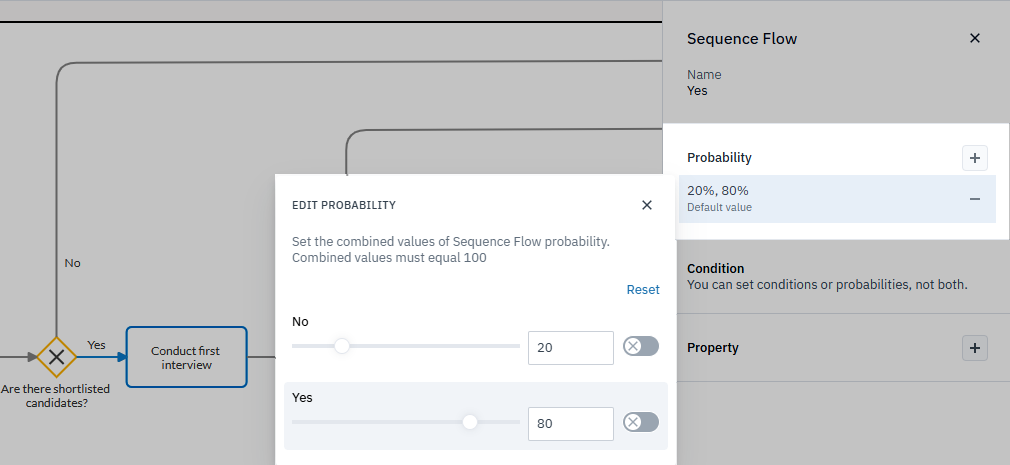Configuring probability-based sequence flows
In the hiring process simulation, decision points are often controlled by assigning probabilities to the outgoing sequence flows. For example, whether a candidate advances to the next stage or is rejected can be modeled using probabilities applied directly to the sequence flows.
Sequence flows route the process from one activity to another. By assigning probabilities to each flow, you can control the likelihood of different outcomes during simulation. These probabilities must sum to 100%.
For example, if a candidate has a 70% chance of advancing and a 30% chance of being rejected, the simulation will randomly select the path based on those weights.
You must configure probabilities directly on outgoing sequence flows, as this keeps the decision logic clear, makes the model more intuitive, and allows for easier updates and maintenance.
Configure probabilities on outgoing sequence flows
To demonstrate how to configure probabilities, let’s look at the sequence flows that exit the first exclusive gateway, Are there shortlisted candidates?. This decision point determines if the process continues based on whether any candidates have been shortlisted. Each outgoing flow represents a possible path in the process: one for candidates who are shortlisted, and one for those who are not.
In this scenario, the company simulates an 80% chance that candidates are shortlisted, and a 20% chance that the process ends due to a lack of suitable candidates.
To configure probability values on the sequence flows:
-
Select the outgoing sequence flow from the Are there shortlisted candidates? exclusive gateway.
-
In the Parameters panel that opens, in Probability, click
and select Add default value. The default setting equally distributes probability across the sequence flows.
-
To set the probability, click the current setting.
-
In the dialog box that opens, use the slider to set the percentage or type the exact value.
You can use the corresponding toggle to lock the value, ensuring it doesn’t change when other values are adjusted.
Sequence flow Probability No 20% Yes 80% 
Set probabilities for other sequence flows
Now that you’ve configured probabilities for one set of sequence flows, use the same steps to assign probabilities for the other outgoing sequence flows in the process. The tables below show the values to enter for each path:
Advance candidate after first interview?
| Sequence flow | Probability |
|---|---|
| No | 50% |
| Yes | 50% |
Advance candidate after technical interview?
| Sequence flow | Probability |
|---|---|
| No | 40% |
| Yes | 60% |
Is candidate approved?
| Sequence flow | Probability |
|---|---|
| No | 10% |
| Yes | 90% |
Is offer accepted?
| Sequence flow | Probability |
|---|---|
| No | 50% |
| Yes | 50% |